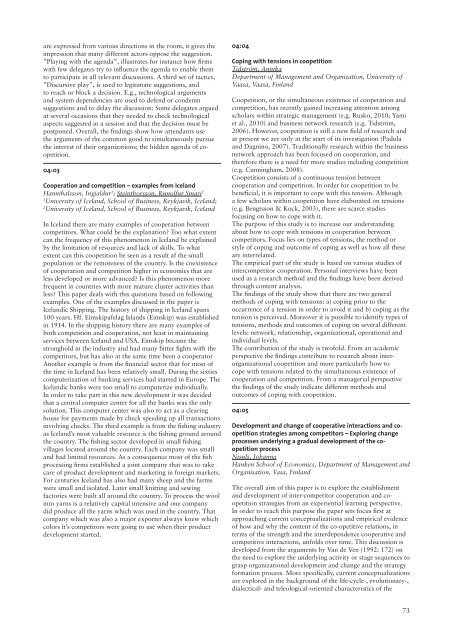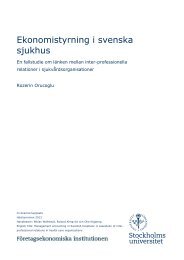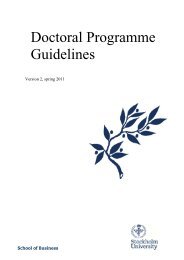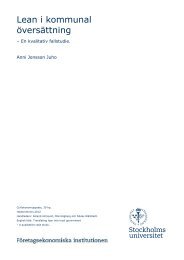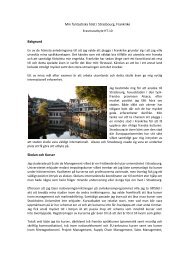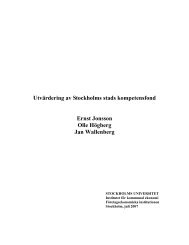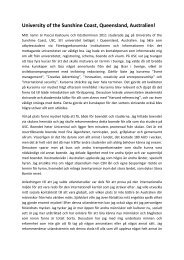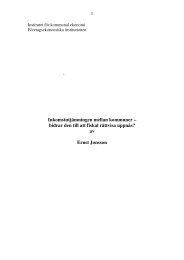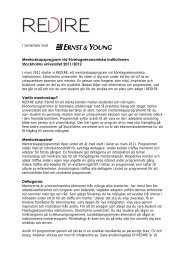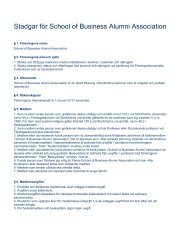Download full programme and abstract book pdf 1.6
Download full programme and abstract book pdf 1.6
Download full programme and abstract book pdf 1.6
You also want an ePaper? Increase the reach of your titles
YUMPU automatically turns print PDFs into web optimized ePapers that Google loves.
are expressed from various directions in the room, it gives the<br />
impression that many different actors oppose the suggestion.<br />
”Playing with the agenda”, illustrates for instance how firms<br />
with few delegates try to influence the agenda to enable them<br />
to participate in all relevant discussions. A third set of tactics,<br />
”Discursive play”, is used to legitimate suggestions, <strong>and</strong><br />
to reach or block a decision. E.g., technological arguments<br />
<strong>and</strong> system dependencies are used to defend or condemn<br />
suggestions <strong>and</strong> to delay the discussion: Some delegates argued<br />
at several occasions that they needed to check technological<br />
aspects suggested in a session <strong>and</strong> that the decision must be<br />
postponed. Overall, the findings show how attendants use<br />
the arguments of the common good to simultaneously pursue<br />
the interest of their organizations; the hidden agenda of coopetition.<br />
04:03<br />
Cooperation <strong>and</strong> competition – examples from Icel<strong>and</strong><br />
Hannibalsson, Ingjaldur 1 ; Steinthorsson, Runolfur Smari 2<br />
1 University of Icel<strong>and</strong>, School of Business, Reykjavik, Icel<strong>and</strong>;<br />
2 University of Icel<strong>and</strong>, School of Business, Reykjavík, Icel<strong>and</strong><br />
In Icel<strong>and</strong> there are many examples of cooperation between<br />
competitors. What could be the explanation? Too what extent<br />
can the frequency of this phenomenon in Icel<strong>and</strong> be explained<br />
by the limitation of resources <strong>and</strong> lack of skills. To what<br />
extent can this coopetition be seen as a result af the small<br />
population or the remoteness of the country. Is the coexistence<br />
of cooperation <strong>and</strong> competition higher in economies that are<br />
less developed or more advanced? Is this phenomenon more<br />
frequent in countries with more mature cluster activities than<br />
less? This paper deals with this questions based on following<br />
examples. One of the examples discussed in the paper is<br />
Icel<strong>and</strong>ic Shipping. The history of shipping in Icel<strong>and</strong> spans<br />
100 years. Hf. Eimskipafelag Isl<strong>and</strong>s (Eimskip) was established<br />
in 1914. In the shipping history there are many examples of<br />
both competition <strong>and</strong> cooperation, not least in maintaining<br />
services between Icel<strong>and</strong> <strong>and</strong> USA. Eimskip became the<br />
stronghold in the industry <strong>and</strong> had many bitter fights with the<br />
competitors, but has also at the same time been a cooperator<br />
Another example is from the financial sector that for most of<br />
the time in Icel<strong>and</strong> has been relatively small. During the sixties<br />
computerization of banking services had started in Europe. The<br />
Icel<strong>and</strong>ic banks were too small to computerize individually.<br />
In order to take part in this new development it was decided<br />
that a central computer center for all the banks was the only<br />
solution. This computer center was also to act as a clearing<br />
house for payments made by check speeding up all transactions<br />
involving checks. The third example is from the fishing industry<br />
as Icel<strong>and</strong>’s most valuable resource is the fishing ground around<br />
the country. The fishing sector developed in small fishing<br />
villages located around the country. Each company was small<br />
<strong>and</strong> had limited resources. As a consequence most of the fish<br />
processing firms established a joint company that was to take<br />
care of product development <strong>and</strong> marketing in foreign markets.<br />
For centuries Icel<strong>and</strong> has also had many sheep <strong>and</strong> the farms<br />
were small <strong>and</strong> isolated. Later small knitting <strong>and</strong> sewing<br />
factories were built all around the country. To process the wool<br />
into yarns is a relatively capital intensive <strong>and</strong> one company<br />
did produce all the yarns which was used in the country. That<br />
company which was also a major exporter always knew which<br />
colors it’s competitors were going to use when their product<br />
development started.<br />
04:04<br />
Coping with tensions in coopetition<br />
Tidström, Annika<br />
Department of Management <strong>and</strong> Organization, University of<br />
Vaasa, Vaasa, Finl<strong>and</strong><br />
Coopetition, or the simultaneous existence of cooperation <strong>and</strong><br />
competition, has recently gained increasing attention among<br />
scholars within strategic management (e.g. Rusko, 2010; Yami<br />
et al., 2010) <strong>and</strong> business network research (e.g. Tidström,<br />
2006). However, coopetition is still a new field of research <strong>and</strong><br />
at present we are only at the start of its investigation (Padula<br />
<strong>and</strong> Dagnino, 2007). Traditionally research within the business<br />
network approach has been focused on cooperation, <strong>and</strong><br />
therefore there is a need for more studies including competition<br />
(e.g. Cunningham, 2008).<br />
Coopetition consists of a continuous tension between<br />
cooperation <strong>and</strong> competition. In order for coopetition to be<br />
beneficial, it is important to cope with this tension. Although<br />
a few scholars within coopetition have elaborated on tensions<br />
(e.g. Bengtsson & Kock, 2003), there are scarce studies<br />
focusing on how to cope with it.<br />
The purpose of this study is to increase our underst<strong>and</strong>ing<br />
about how to cope with tensions in cooperation between<br />
competitors. Focus lies on types of tensions, the method or<br />
style of coping <strong>and</strong> outcome of coping as well as how all these<br />
are interrelated.<br />
The empirical part of the study is based on various studies of<br />
intercompetitor cooperation. Personal interviews have been<br />
used as a research method <strong>and</strong> the findings have been derived<br />
through content analysis.<br />
The findings of the study show that there are two general<br />
methods of coping with tensions: a) coping prior to the<br />
occurrence of a tension in order to avoid it <strong>and</strong> b) coping as the<br />
tension is perceived. Moreover it is possible to identify types of<br />
tensions, methods <strong>and</strong> outcomes of coping on several different<br />
levels: network, relationship, organizational, operational <strong>and</strong><br />
individual levels.<br />
The contribution of the study is twofold. From an academic<br />
perspective the findings contribute to research about interorganizational<br />
coopetition <strong>and</strong> more particularly how to<br />
cope with tensions related to the simultaneous existence of<br />
cooperation <strong>and</strong> competition. From a managerial perspective<br />
the findings of the study indicate different methods <strong>and</strong><br />
outcomes of coping with coopetition.<br />
04:05<br />
Development <strong>and</strong> change of cooperative interactions <strong>and</strong> coopetition<br />
strategies among competitors – Exploring change<br />
processes underlying a gradual development of the coopetition<br />
process<br />
Nisuls, Johanna<br />
Hanken School of Economics, Department of Management <strong>and</strong><br />
Organisation, Vasa, Finl<strong>and</strong><br />
The overall aim of this paper is to explore the establishment<br />
<strong>and</strong> development of inter-competitor cooperation <strong>and</strong> coopetition<br />
strategies from an experiential learning perspective.<br />
In order to reach this purpose the paper sets focus first at<br />
approaching current conceptualizations <strong>and</strong> empirical evidence<br />
of how <strong>and</strong> why the content of the co-opetitive relations, in<br />
terms of the strength <strong>and</strong> the interdependence cooperative <strong>and</strong><br />
competitive interactions, unfolds over time. This discussion is<br />
developed from the arguments by Van de Ven (1992: 172) on<br />
the need to explore the underlying activity or stage sequences to<br />
grasp organizational development <strong>and</strong> change <strong>and</strong> the strategy<br />
formation process. More specifically, current conceptualizations<br />
are explored in the background of the life-cycle-, evolutionary-,<br />
dialectical- <strong>and</strong> teleological-oriented characteristics of the<br />
73


